Contents
- Crop Cultivation
- Agricultural Communities
- Festivals/Rituals Related to Farming
- Bendur
- Types of Farming
- Hybrid Farming
- Magachi Terracing Scheme
- Traditional Agricultural Practices
- Traditional varieties of Crops
- Bird nests and their relationship with floods
- Use of Technology
- Hydroponic Farming
- Institutional Infrastructure
- Rajarshee Chhatrapati Shahu Maharaj College of Agriculture
- Market Structure: APMC
- List of APMC markets(as of September 2024)
- Farmers Issues
- Impact of Changing Climate Conditions
- Graphs
- Irrigation
- A. No. of Projects
- B. No. of Ponds/Vilage Lakes and Storage Dams
- C. Irrigation Beneficiary Area vs Irrigated Area
- D. Share of Beneficiary Area Irrigated
- E. Tubewells and Pumps Installed In The Year
- F. Irrigation and Water Pumping Facilities
- Cropping Metrics
- A. Share in Total Holdings
- B. Cultivated Area (With Components)
- C. Gross Cropped Area (Irrigated + Unirrigated)
- D. Share of Cropped Area Irrigated
- E. Distribution of Chemical Fertilizers
- Land Use and Credit
- A. Area of Agricultural Land Holdings (With Size Group)
- B. Size Groups' Share in Total Agricultural Land Holdings Area
- C. No. of Agricultural Land Holdings (With Size Group)
- D. Size Groups' Share in Total No. of Agricultural Land Holdings
- E. Agricultural Lending
- F. Agricultural Credit as a share of Total Credit
- Sources
KOLHAPUR
Agriculture
Last updated on 6 November 2025. Help us improve the information on this page by clicking on suggest edits or writing to us.
The Kolhapur district lies in the North Sahyadris and Western Karnataka plateau region. Its favorable climate and fertile black and laterite soils support diverse agricultural activities. Sugarcane, Paddy, and Groundnut are the most common crops. The district is drained by rivers such as Ghatprabha, Tamraparni, Dudhganga, Krishna, Bhogawati, Warna, Kasari, Panchaganga, Wedganga, and Kumbhi (refer to the Environment Chapter for more).
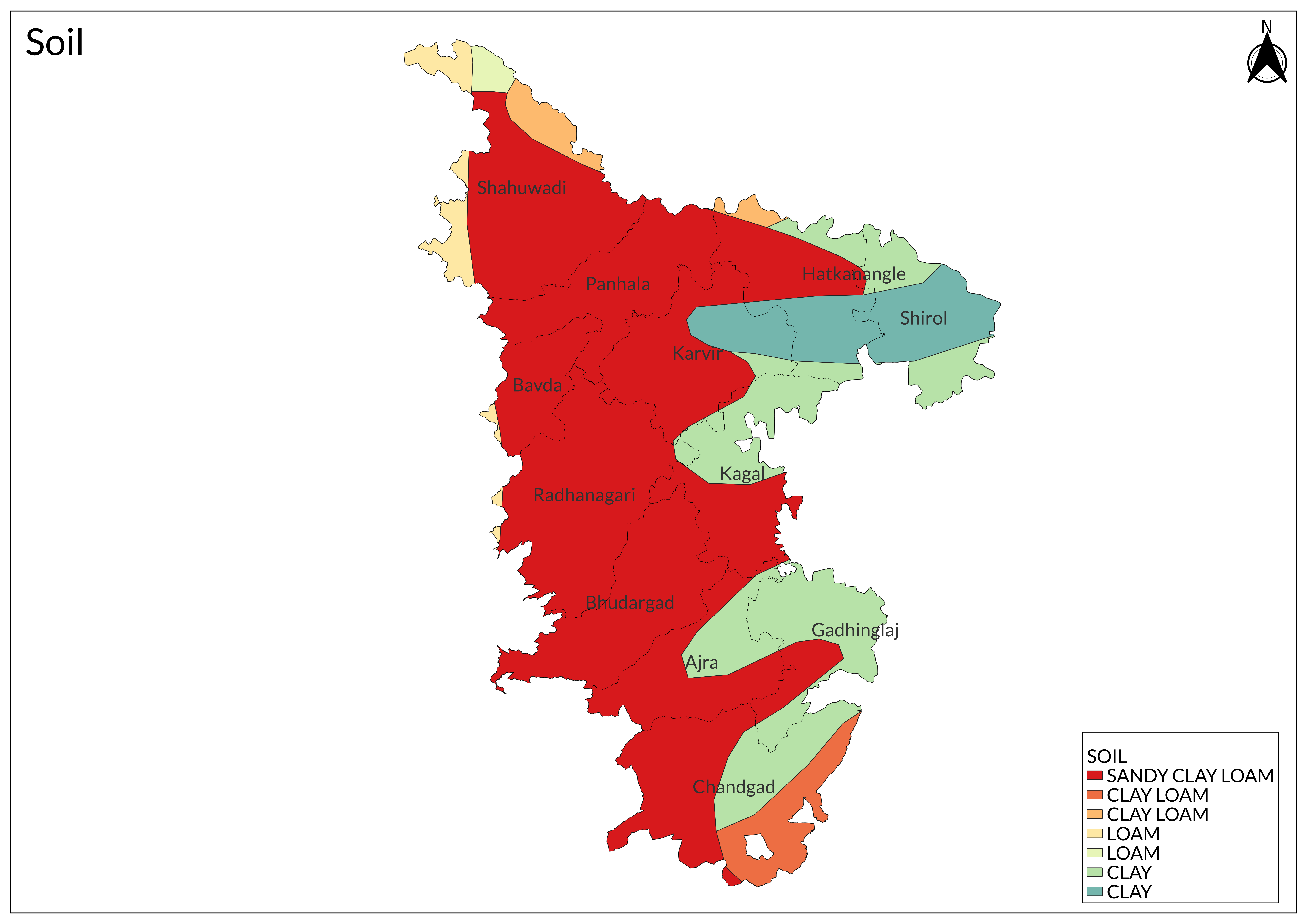
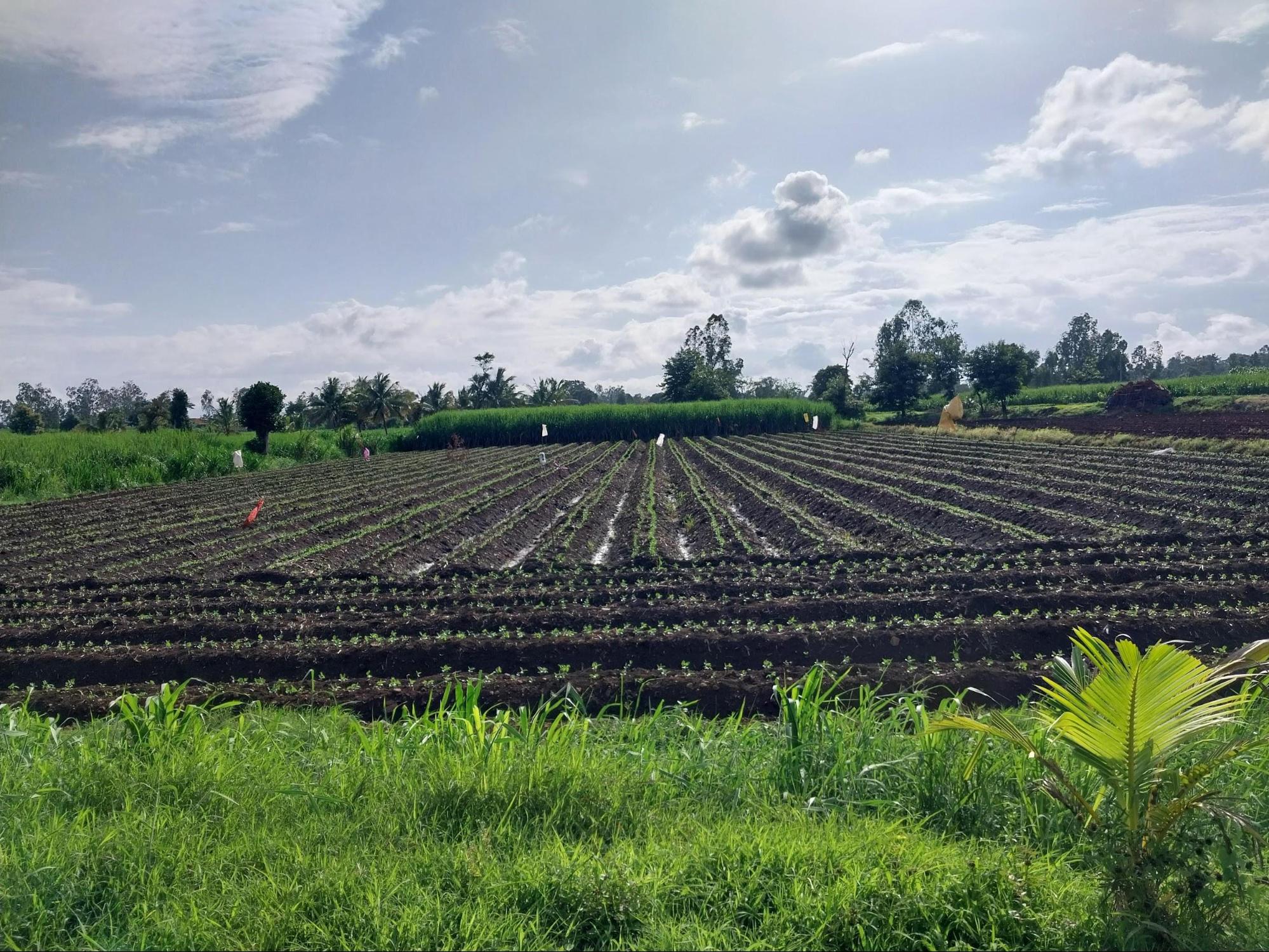
Crop Cultivation
Kolhapur district is known for its rich agricultural practices, including a growing emphasis on organic farming, where farmers utilize natural methods to cultivate crops without chemicals. Agriculture plays a vital role in the local economy, with rice historically serving as the staple crop. It is noted in the district Gazetteer (1960) that in the 1955-56 period, rice accounted for approximately 40% of the cereal crop area, particularly in the western talukas of Shahuwadi, Karvir, Radhanagari, Panhala, Bhudargad, and Kagal, which collectively contributed to over 70% of the district’s rice production.
Traditionally, rice was sown in June and harvested by mid-September, featuring varieties such as the aromatic Black Jirrga and the Ghansal rice of Ajra, the latter of which also has a GI tag. Other notable varieties included sakharsal and kolam, while less favored types encompassed aviste, havale-mothe, and patni. Today, Kolhapur's agricultural heritage boasts several traditional rice varieties, including Dodki, Indrayani, and Basmati, each prized for its unique flavor.
While rice remains the most widely cultivated cereal, jowar has also historically been significant, particularly during the kharif season. Groundnut varieties such as Jal 24 and Dhanlaxmi have also played a vital role in local cuisine, alongside wheat and jowar, which are integral to the region’s diet.
Currently, locals report that agricultural output includes staple grains such as rice, wheat, and jowar, alongside fruits like pineapple, watermelon, and bananas, as well as spices like ginger and turmeric. In recent years, a shift in market demand has led farmers to cultivate more profitable crops, including mangoes, grapes, and vegetables like tomatoes and onions. Sugarcane has also become increasingly important due to its demand for jaggery and sugar production. The Kolhapur jaggery received a GI tag in 2014, further increasing the demand for Sugarcane. Flowers, including roses and marigolds, are now common agricultural products as well.

With the introduction of new crops, some traditional crops like moong dal, tobacco, and cotton have seen a decline in cultivation. This change is attributed to low market demand and inadequate profits, compelling farmers to choose crops that promise better financial stability. Environmental factors, such as shifting rainfall patterns and pest issues, have also influenced these decisions.

According to local farmers, several crops that were once common, such as moong dal, tur, matki, tobacco, cotton, bajra, and nachni, are now rarely cultivated. These crops were historically popular and fetched good prices, but various factors have led to their decline. The primary reasons include low market demand and insufficient profit margins compared to more lucrative alternatives. Farmers increasingly find that these traditional crops do not provide enough income to support their families or invest in their farms, prompting them to shift focus toward more stable and profitable options.
Environmental changes, including altered weather patterns, have also influenced farmers' decisions. New technologies and improved farming methods have made it easier to grow certain crops, which may require less care. Additionally, persistent issues with diseases and pests further push farmers to abandon less profitable crops in favor of those that yield better returns.
Consequently, the agricultural landscape has evolved, with farmers prioritizing sustainability and financial viability. Staple grains such as wheat and jowar continue to be vital, with traditional wheat varieties like Kolam, Shetggav, and Paanghav, as well as local jowar varieties like Shalu, Dukrya, and Hybrid. These grains remain integral to local diets and farming practices, reflecting the adaptability of farmers in response to changing economic, technological, and environmental conditions.
Kolhapur district benefits from various agricultural schemes designed to support local farmers. The Cashew Plantation Scheme, initiated in 1965, has helped farmers cultivate cashew nuts in the Western Ghats, with government loans and aid facilitating their success. The Mango Plantation Scheme, introduced in 1975, encourages the use of unused lands for mango cultivation, providing 50% government funding.
Additional initiatives include reclaiming saline lands through trench digging and promoting cooperative agriculture since 1985. Turmeric and betel leaf are also major crops, enhancing the agricultural diversity of the region. Furthermore, dairy development has been significant since 1961, with organizations like Gokul and Varana assisting farmers in milk production and distribution.
Horticulture and floriculture have seen notable growth since the late 1950s. Initially, only 1,600 hectares were dedicated to these practices, but this area has expanded significantly. Each district now has a dedicated government department for horticulture and floriculture, capitalizing on the favorable climate for growing various fruits such as guava, mango, bananas, papaya, oranges, lemons, grapes, and a local variety of cardamom known as velachi.
Agricultural Communities
In the past, according to the locals, specific communities in Kolhapur were closely associated with the cultivation of particular crops. The Maratha community primarily cultivated jowar, while banana farming was predominantly undertaken by the Lingayat community. Sugarcane, a crucial crop for sugar and related products, was grown by both the Marathas and the Gaud Saraswat Brahmins. However, over time, these traditional associations have evolved. Today, there are no strict restrictions on which community can grow which crop, leading to a more diverse agricultural landscape where farmers from various backgrounds cultivate a wide range of crops.
Agricultural work in Kolhapur involves different types of laborers. Seasonal workers often migrate from states like Karnataka and Uttar Pradesh during peak times, such as the sugarcane harvest, and return home once their work is complete. Local laborers, who are residents of nearby villages, provide year-round support on farms, engaging in tasks such as sowing, plowing, and applying fertilizers. Their daily wages range from 80 to 100 rupees, which is relatively low compared to nearby districts. Additionally, regular workers, known as “gadhi," are locals who work full-time on farms, managing various farm tasks and animals, with many also hailing from Karnataka.
Farmers in Kolhapur face several significant challenges. One major issue is water scarcity; irregular rainfall and limited irrigation systems can hinder crop growth. Additionally, fluctuating crop prices can severely impact farmers' income, making it difficult for them to cover their expenses on seeds, fertilizers, and machinery. Climate challenges, including droughts, floods, and extreme temperatures, can also damage crops, resulting in lower yields or total losses.
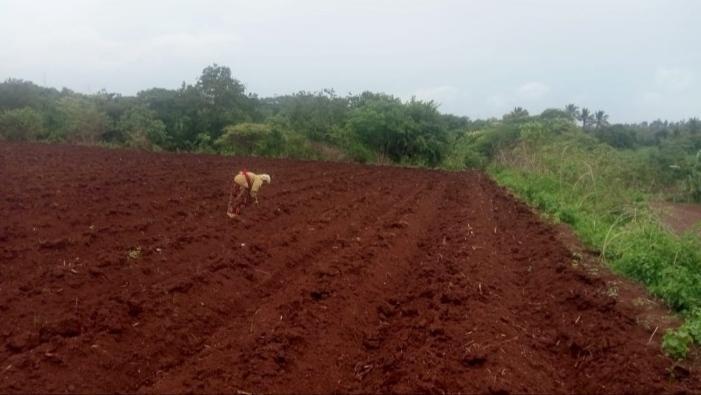
Women play a crucial role in agriculture in Kolhapur. They actively participate in various farming activities, such as planting seeds, harvesting crops, and caring for livestock. Women also influence key decisions related to farm management and finances, including crop selection. Despite their essential contributions, their roles often remain limited to labor, and societal attitudes can hinder their advancement as landowners or entrepreneurs in farming.
Contract farming is another significant aspect of agriculture in Kolhapur. In this arrangement, farmers enter agreements with buyers to grow specific crops, ensuring a market for their produce upon harvest. Additionally, landowners who cannot farm due to jobs or other commitments often hire other farmers to cultivate their land, creating a mutually beneficial relationship. This system provides guarantees of crop sales and often includes support from buyers in the form of better seeds and farming techniques, which can enhance crop quality and yield.
However, contract farming is not without its issues. Farmers often experience delays in payment and fluctuations in crop prices, which can strain their finances. Unclear agreements can lead to misunderstandings about payment amounts, and farmers may face risks associated with crop failures without adequate support from landowners. These challenges highlight the complexities of contract farming in Kolhapur district and the need for better structures to protect farmers' interests.
Festivals/Rituals Related to Farming
Bendur
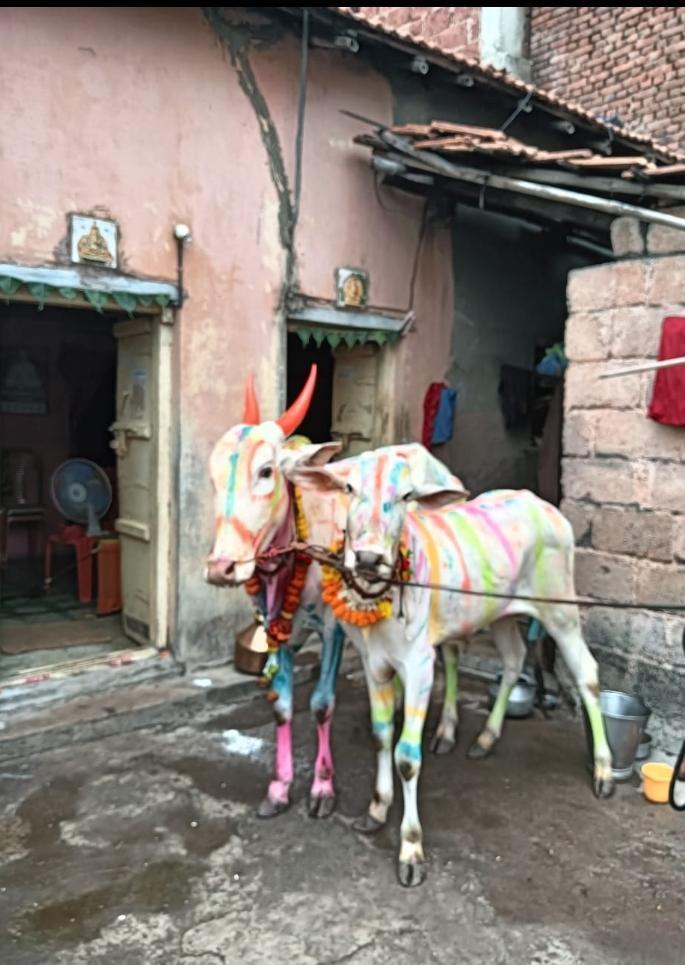
'Bendur' is a festival celebrated primarily in the border districts of Western Maharashtra and Karnataka. In other parts of Maharashtra, this festival is known as 'Pola.' While the essence and rituals of Bendur and Pola remain the same, the two are celebrated on different days. Bender takes place during the first full moon of the month of Ashadh and is observed as a day of gratitude towards the Sarja Raja, the hardworking bull that toils in the fields.
On this day, cows and bulls are bathed early in the morning. Their horns are then painted and adorned with ornaments. Additionally, two clay bulls are brought into the home, worshipped, and offered Puranpoli as Naivedya (a sacred food offering).
A unique ritual involves washing the upper part of the bull’s neck, known as the shoulder. The bull’s shoulders are soaked in hot water and then smeared with turmeric. On the day of Bendur, bulls are given complete rest and are not used for any work.
In the evening, the bulls are worshipped and taken out in a grand procession accompanied by the rhythmic beats of drums and cymbals. This vibrant celebration highlights the deep bond between humans and the animals that sustain their livelihoods.
Types of Farming
Kolhapur district is characterized by diverse farming practices that reflect the adaptability and resourcefulness of local farmers. Various agricultural methods are employed to respond to changing environmental conditions and market demands. Farmers in Kolhapur district express significant concerns about the challenges posed by climate change. According to locals, rainfall patterns have become increasingly unpredictable, leading to years of excessive rainfall followed by drought. This variability complicates planning for planting and harvesting crops.
Hybrid Farming
While traditional crops like rice, jowar, and pulses remain significant, hybrid farming has gained traction. Farmers report that hybrid varieties, such as maize, tomatoes, carrots, and brinjal, provide higher yields and better resistance to pests, making them more lucrative. These crops are also easier to cultivate and tend to have longer lifespans than traditional varieties.
Magachi Terracing Scheme
To combat land erosion caused by heavy rains, particularly in the Western Ghats, conservation efforts have been implemented. The Majagi terracing scheme, introduced in 1991, costs Rs. 3,300 per hectare, with 67% of the funding provided by the government. This local terracing method helps retain soil and enhance productivity through the use of natural manure. Bunding systems, initiated in 1954 in areas like Shintre, Hatkanangale, and Godhinglaj, have supported 50,000 hectares by 1991, with government contributions covering 25% of costs.
Nala bunding, which began before independence and continues today, spans 202 streams, aiding groundwater recharge, vegetation growth, and soil fertility across various talukas. These widespread efforts illustrate the proactive measures being taken to ensure agricultural sustainability in the Kolhapur district.
Traditional Agricultural Practices
Traditional varieties of Crops
The Ajara Ghansal variety of Rice, grown in the Ajara taluka, is well known, particularly for its taste and aroma. The variety is fondly known as the ‘King of Rice’ as the grain is small and thin and is highly aromatic. Its name is derived from two words- one is ‘Ghan’ means ‘Aroma’ and ‘Flavour’, and ‘Sal’means ‘elegant paddy’. The variety is also famous for being Pure (Satvik). The production period and cost required for the cultivation of this variety are generally high. The yield per acre is less, but the rate received is high, and thus the rice has proven to be highly profitable when compared to other varieties of rice.
Recently, Ajara Ghansal rice received the GI certification and is set to be cultivated on 100 hectares in Polgaon as part of a conservation effort initiated in 2008. Supported by the Zilla Parishad, the Agriculture Department, and Ajara Taluka Shetkari Mandal, this initiative includes subsidies and aims to increase the paddy cultivation area. The high demand and favorable pricing for this rice have led farmers to focus on it, with plans for 750 to 1,500 acres this year, alongside other varieties like Amogh and Shubhangi.
Corn is another crop whose traditional varieties are still grown, albeit on a limited scale. Narayan and Kusum Gaikwad, residents of Jambhali village in Shriol taluka, cultivate the off-white kabburi Makka twice a year. However, most others in the village have abandoned this native variety in favor of newer hybrid crops. Once widely grown in the villages of western Maharashtra and northern Karnataka, kabburi makka was prized for its superior taste and nutritional value compared to other maize varieties. Unfortunately, like many indigenous crops, it began to disappear with the advent of the Green Revolution and the widespread adoption of hybrid varieties.
Corn is traditionally used to prepare dishes such as kabburi makka porridge and flatbread, which have also faded into obscurity with the rise of hybrid cultivation. Despite its lower yield and limited profitability, Kusum and Narayan Gaikwad remain steadfast in their efforts to preserve this native variety. They have also been working to encourage other farmers to return to cultivating kabburi makka, but sadly, their attempts have met with little success.
Bird nests and their relationship with floods
In addition to this, there's a somewhat popular belief about bird nests and floods in the district. It is believed that if a bird builds its nest low in a tree, it's said that there won't be a flood. But if the nest is high up in the tree, it means a flood might be coming. This idea has been passed down traditionally and is still widely practiced.
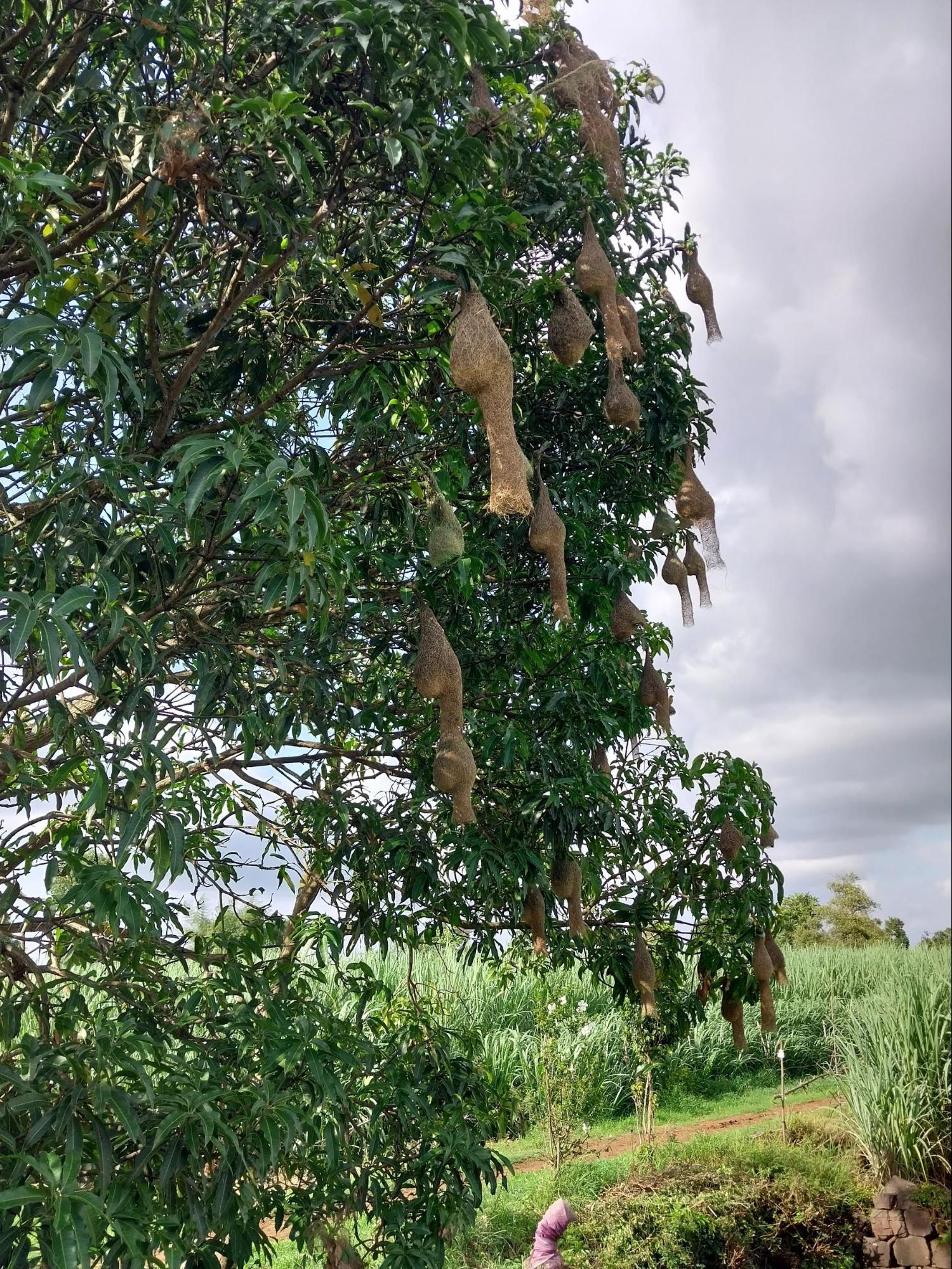
Use of Technology
The district has a considerable number of agricultural tractors, power tillers, threshers, and other agri-tech services, but locals say that some farmers do not use them because they are either unaffordable or due to a lack of awareness about their benefits.

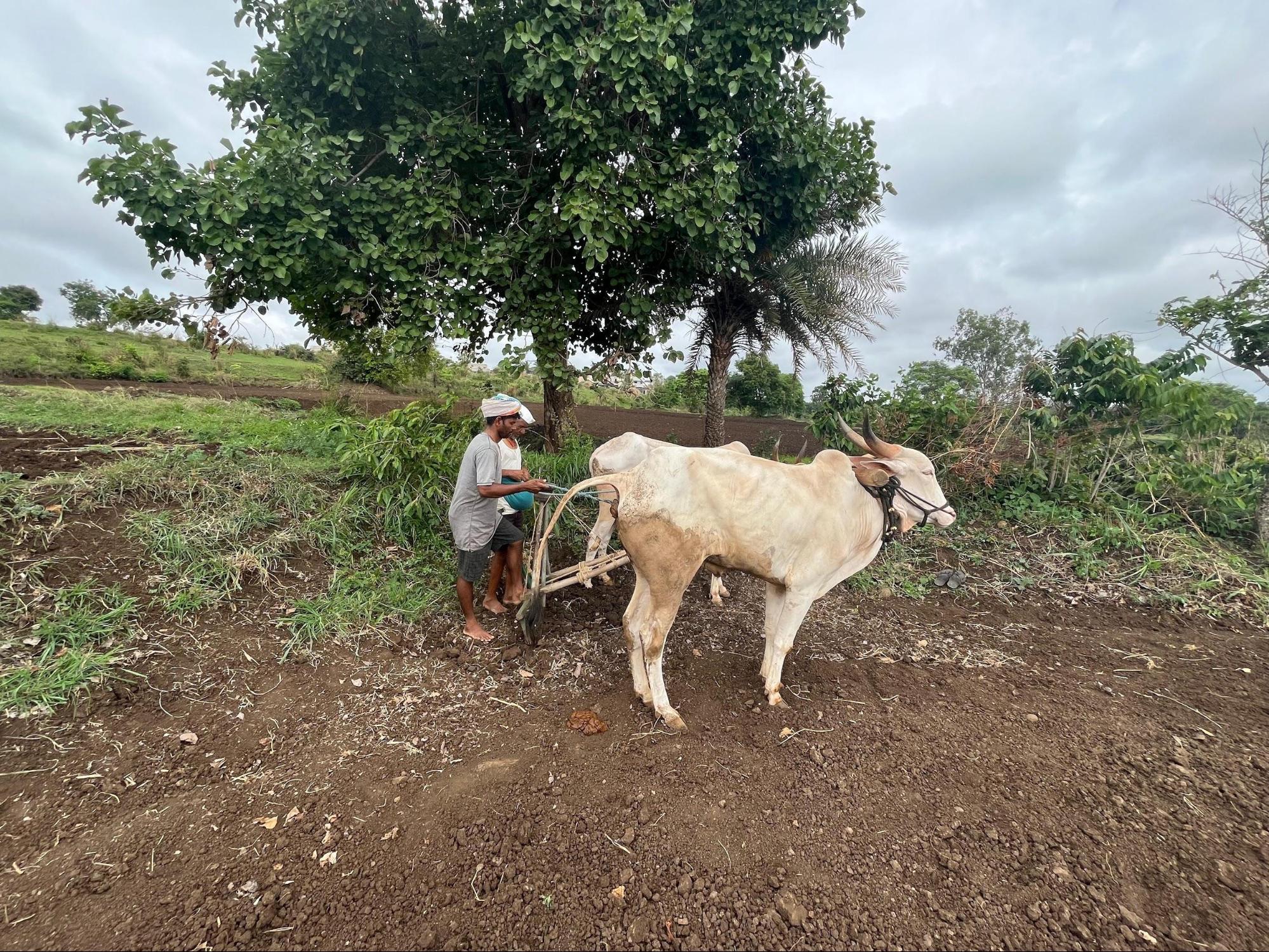
The district is home to various dams and reservoirs that aid in irrigation, such as Tilari and Randhangiri hydroelectric projects and Chikotra, Kasari, Kadari, Jambhali, Gudavale, and Kumbhi medium projects. Wells and Pumps are also utilized for irrigation in a few places.
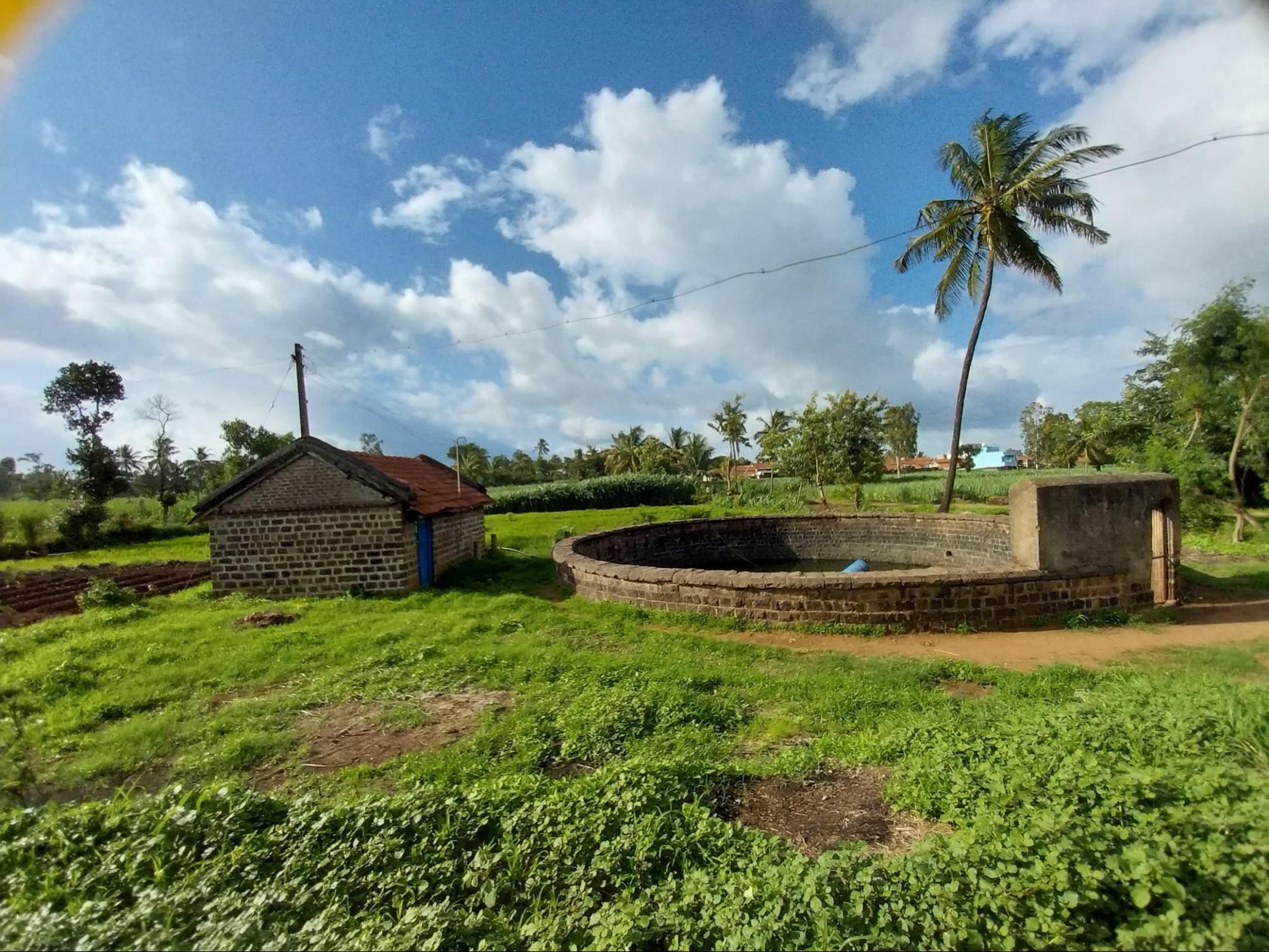
Hydroponic Farming
Hydroponic and aquaponic farming, along with other sustainable agricultural methods, are gradually gaining traction in India, demonstrating that farming can be both environmentally sustainable and economically profitable. Hydroponics involves growing crops without soil, using water-based mineral nutrient solutions in a controlled environment. Aquaponics, on the other hand, is a system that combines hydroponics with aquaculture, where plants and fish are cultivated together in a symbiotic environment. The fish produce waste that is converted into nutrients for the plants, while the plants help to filter and purify the water for the fish.
In April 2019, Mayank Gupta and Lalit Jhawar, both IIT graduates, established LandCraft Agro, a 23-acre hydroponic and aquaponic farm in Ichalkaranji, about 30 kilometers from Kolhapur city. In addition to managing their farm, they trained around 150 farmers to convert 100 acres of land into polyhouses for vegetable cultivation. The farm grows over 40 types of primarily exotic vegetables, including kale, lettuce, pak choi, mushrooms, sage, and spinach, under the brand name Trueganic.
The vegetables are distributed to cities such as Hyderabad and Chennai and even flown to Delhi, as well as various locations in Maharashtra. By 2020, LandCraft Agro reported a monthly turnover of ₹80 lakh, with women making up approximately 80% of their workforce.
Institutional Infrastructure
Kolhapur has an average developed agricultural infrastructure, which includes 4 Agricultural Produce Market Committees (APMCs), 760 godowns, 17 cold storages, 13 soil testing centers, 650 farmers clubs, 22 plantation nurseries, and approximately 3800 fertilizer, seed, and pesticide outlets. There are two Krishi Vigyan Kendras (KVKs) supporting agricultural extension services in the region. In addition to this, there are 28 commercial banks, 1 Regional rural bank, and District Central Cooperative bank, 8 branches of Vidharbha Konkan Gramin Bank, 192 branches of Kolhapur DCCB, and 1877 Primary Agricultural. Cooperative Societies. However, there is a high level of concentration of branches of commercial banks in Karvir, Hatkanangle, and Shirol talukas, while the branch network is poor in the western hilly talukas of the district.
Rajarshee Chhatrapati Shahu Maharaj College of Agriculture
The College of Agriculture, Kolhapur was established at Kasaba Bawada, Kolhapur on 30 June 1963 to educate and disseminate need-based agricultural technologies to the farming community of this region under the Shivaji University, Kolhapur. About 63 students were admitted for the first batch. In 1968, after the formation of Maharashtra Agricultural University, the College was transferred to this University. Subsequently, on the formation of Mahatma Phule Krishi Vidyapeeth, Rahuri in 1969, the College was transferred as a constituent College of Mahatma Phule Krishi Vidyapeeth, Rahur, and has become a regional headquarters for Kolhapur, Satara, and Sangli districts.
The college was renamed Rajarshee Chhatrapati Shahu Maharaj College of Agriculture, Kolhapur, in March 2017 to honor Shahu Maharaj (1874-1922), a renowned social reformer and dynamic king of the then Kolhapur princely state. Currently, it provides a B.Sc (Hons) and M.Sc (Agri) in Agriculture, Botany, Agronomy, Animal Husbandry and Dairy Science, Agril. Economics, Agril. Entomology, Extension Education, Horticulture, Plant Pathology, Soil Science, and Agril. Chemistry.
Market Structure: APMC
There are APMCs at Gadhinglaj, Jaysingpur, Kolhapur City, and Vadgaon Peth. The APMC at Kolhapur was established in 1945 and is the oldest of all. Paddy(Unhusked), Jaggery, Tobacco, Groundnut, Jowar, Mango, Potato, Onions, Maize, etc, are some of the important commodities that are sold at these markets.
List of APMC markets(as of September 2024)
|
Sr. No |
Name |
Est. Year |
Chairman |
No. of Godowns |
|
1. |
Gadhinglaj |
1947 |
Ramdas Bharam Patil |
1 |
|
2. |
Jaysingpur |
1961 |
Subhashsing Gopalsing Rajput |
4 |
|
3. |
Kolhapur |
1945 |
Satpal Dnyanu Salunke |
481 (400 Belonging to Priv. org) |
|
4. |
Vadgaon Peth |
1961 |
Vilas Babaso Khanavilkar |
4 |
Farmers Issues
Farmers in Kolhapur face problems such as unstable prices of crops, erratic rainfall, lack of necessary capital, etc.
Impact of Changing Climate Conditions
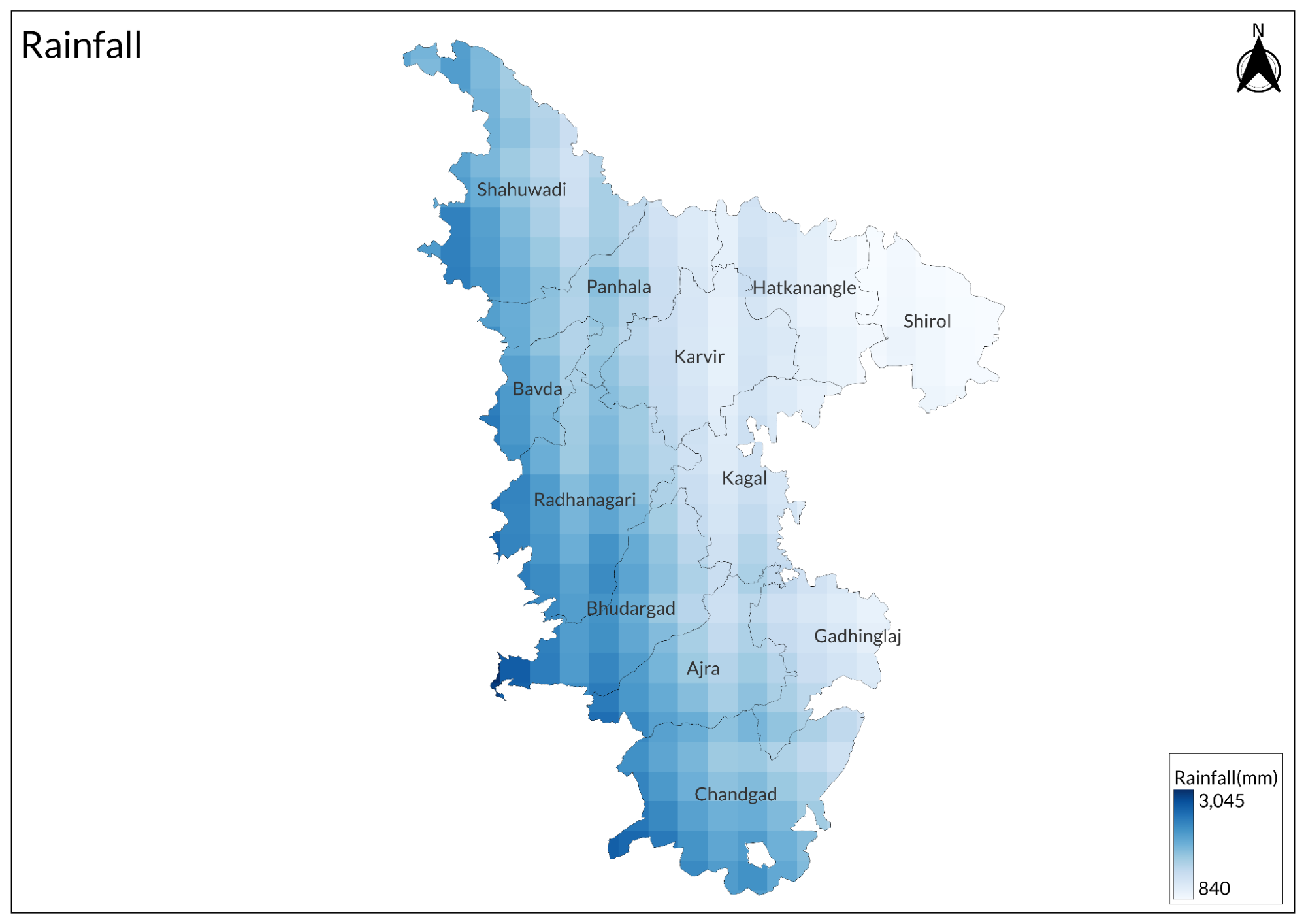
This climate change also had a huge impact on the crops. In past years, crops like tur moong dal, matki, and bajra were grown, but due to this sudden climate change, these crops are now rarely grown. Nowadays, crops like sugarcane, soybean, various fruits, vegetables, pulses, etc, are cultivated, which are suitable for this environment.
Graphs
Irrigation
Cropping Metrics
Land Use and Credit
Sources
About Ackolhapur. Ackolhapur.edu.inhttps://www.ackolhapur.edu.in/about-us/
BBC News Marathi. 2020. Acrophonic Hydrophonic Farming: Maharashtra च्या Kolhapur मध्ये पाण्यावर तरंगणारी शेती आहे कशी?. You Tube.https://www.youtube.com/watch?v=B8m35i1Ajg4
Govt. Of Maharashtra. 1960. District Gazetteers, Kolhapur District.Gazetteers Dept. Mumbaihttps://gazetteers.maharashtra.gov.in/cultur…
Himanshu Nitnaware. 2020.IIT Grads With Zero Farming Experience Earn Rs 80 Lakh/Month From Exotic Veggies.The Better India.https://thebetterindia.com/244527/landcraft-…
ICAR. 2017. Maharashtar Agriculture Contingency Plan for District: Kolhapur. ICAR - CRIDA - NICRA
NABARD. 2023-24. Potential Linked Credit Plan: Kolhapur. Maharashtra Regional Office, Pune.
R. N Bolake, D.S Patil. 2020. Ghansal rice result of Green revolution: A Case study of Ajara Taluka Dist Kolhapur. Vol. 40, no. 42.Studies in Indian Place Names (UGC Care Journal).https://tpnsindia.org/index.php/sipn/article…
Sanket Jain. 2024. Sole saviour: How one Maharashtra family has saved the kabburi makka. DownToEarth.https://www.downtoearth.org.in/agriculture/s…
Snehal Satghare. 2022. Maharashtra Bendur : काय आहे बेंदूर सण? जाणून घ्या महाराष्ट्रातील या अनोख्या सणाचं महत्व आणि वैशिष्ट. Marathi.latestly.https://marathi.latestly.com/lifestyle/festi…
Last updated on 6 November 2025. Help us improve the information on this page by clicking on suggest edits or writing to us.